Market
David Ebony’s Top 10 New York Gallery Shows for April
Check out the best of what's on at New York's top contemporary art galleries.
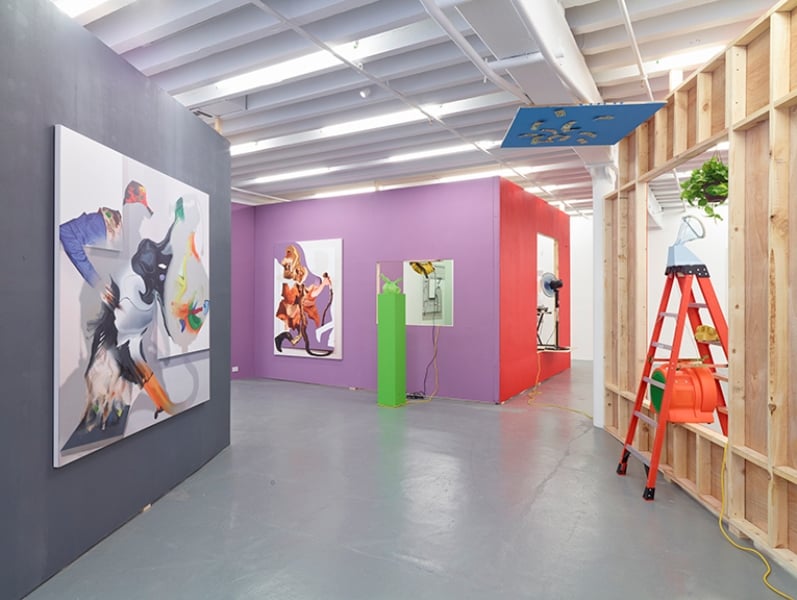
Check out the best of what's on at New York's top contemporary art galleries.

David Ebony

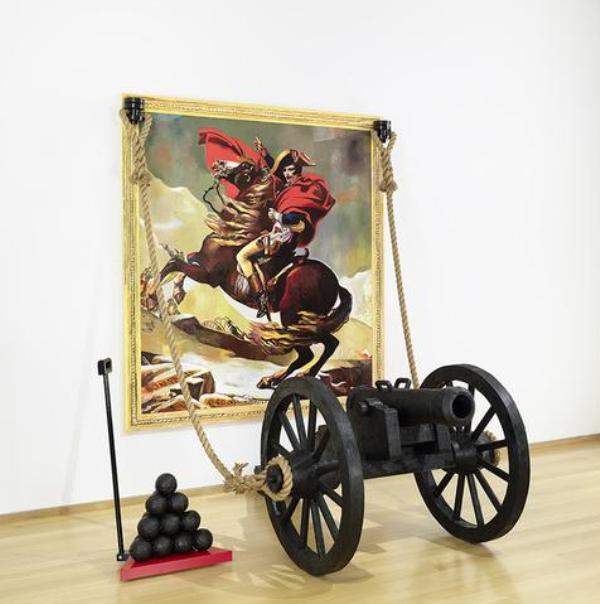
Malcolm Morley, Napoleon Crossing the Alps with Cannon (2014).
Photo: Courtesy Sperone Westwater.
1. Malcolm Morley at Sperone Westwater, New York, through June 6.
The Napoleonic Wars are still raging—at least in several recent works by Malcolm Morley in this terrific show. Armed conflict has long been a central theme in works by the legendary painter. He uses children’s toys, especially airplanes and warships, as models for elaborate war narratives that seem incongruous, played out in clashing historical periods, and unlikely geographical settings. This exhibition is no exception.
Napoleon Crossing the Alps with Cannon (2014) is a striking painting-installation, featuring a large canvas that mimics Jacques-Louis David’s heroic equestrian portrait commemorating Napoleon’s foray into Austria in 1800. As a matter of historical fact, Napoleon actually rode a donkey and lugged a cannon through the mountains, which Morley humorously conveys here with 3-D elements, including a realistic-looking cannon and a pile of cannon balls, all made of paper covered in black encaustic. Elsewhere, Admiral Lord Nelson and the Duke of Wellington strike dashing poses in Trafalgar-Waterloo (2013), with their portrait panels separated by a life-size cannon barrel rendered in low-relief.
Morley culls most of the images in the show from his childhood memories of World War II. He witnessed his toy ships and airplanes being blasted from their shelves as his family’s London apartment was bombed in the Blitz. The family survived, though their material possessions vanished in a flash. There is sorrow and joy in that story, just as in each of the seventeen works on view here.
The Turner Prize winner, now 83, manages to imbue his poignant war tales with touches of humor, and delivers them with masterful, painterly panache. At the show’s opening, my friend and colleague Walter Robinson likened the works in this exhibition to late Picassos, and the analogy seems apt. After an extraordinary career spanning nearly six decades, Morley today produces works whose childlike freshness conveys more than ever an exuberant outlook on life, despite all of its conflicts and mayhem.
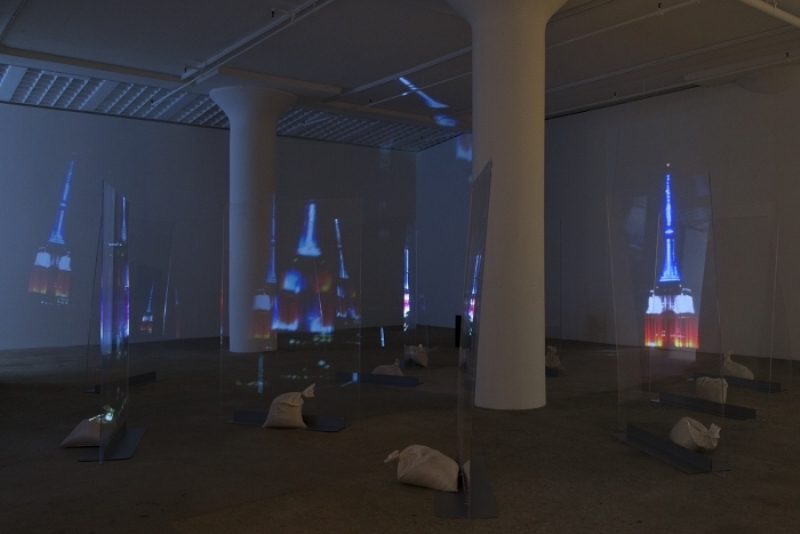
Lutz Bacher, Empire (2014).
Photo: Courtesy Greene Naftali.
2. Lutz Bacher at Greene Naftali, through May 9
This wonderfully enigmatic show, “For the People of New York City,” features a diverse group of recent installations, photos, and works on paper by New York–based multimedia artist Lutz Bacher that fill both venues of this Chelsea gallery. The works she presents here are wildly disparate in terms of materials and subject matter, yet they form a surprisingly cohesive and powerful whole.
The centerpiece of the show, Empire (2014), is an immersive video installation featuring moving images of the Empire State Building (as if shot from a car) projected on a dozen or so large rectangular Plexiglas panels fitted into metal supports, and weighted to the floor by sand bags. Illuminated at night by red, white, and blue floodlights—perhaps on the Fourth of July—the iconic building appears in the projections to constantly shift or turn; its rainbow hues transforming the panels into dazzling prisms. Further enhancing the hypnotic effect, a roaring, buzzing electronic soundtrack suggests a relentless though lyrical cacophony of ambient street sounds.
Less aggressive but similarly uncanny, an installation in a rear gallery features on one wall, a large, gorgeous photo of a young woman seated outside a white-stucco building in what appears to be an icy and exotic locale. Visitors who dare to get a closer look need be wary of the many marbles strewn about the gallery floor, lest they trip on the hazardous approach. Indicative of this show’s sly agenda, resisting rational interpretation, the installation suggests a cautionary tale, both metaphorical and real.
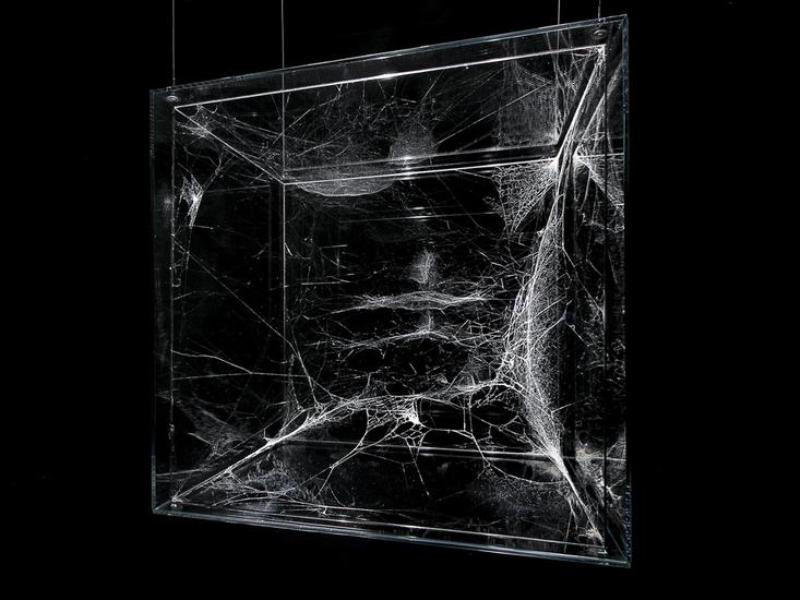
Tomás Saraceno, Hybrid solitary social semi-social musical instrument Apus: built by one Nephila clavipes-six days- a small commuity of Stegudyphus duffori-four months-and six cyrtophora citricola sipiderlings-two weeks (2015).
Photo: Courtesy Tanya Bonakdar Gallery.
3. Tomás Saraceno at Tanya Bonakdar, through May 2.
Anyone afraid of spiders ought to take in this show for a cure. You’d at least come away with a profound appreciation for their creativity. “Hybrid, solitary… semi social quintet…on cosmic webs…,” a show of recent works by Tomás Saraceno, features a half-dozen Plexiglas boxes filled with real spider webs.
Dramatically lit from above or below by spotlights in the large street-level gallery, the beautifully intricate constructions made by these industrious creatures over the course of weeks or months, are clearly visible in all their fantastic detail. One work in progress contains a live spider you can observe in the process of creating one of these delicate pieces, incredibly transported here from the artist’s studio in Berlin. Adding to the show’s eerie atmosphere, a soundtrack fills the room with amplified sounds of spiders plucking the strings. Some arachnologists believe this to be the spiders’ musical means of communication.
As the heart of the exhibition, the spider web installation is a tour de force. It is fair to say, however, that the spiders have done most of the work. But the show also contains a fine selection of more characteristic Saraceno works in the upper level gallery, which demonstrate how this brilliant young artist from Argentina, now residing in Germany, merges science and art in airy constructions of wires and pod-like shapes that suggest imaginative, futuristic works of architecture.
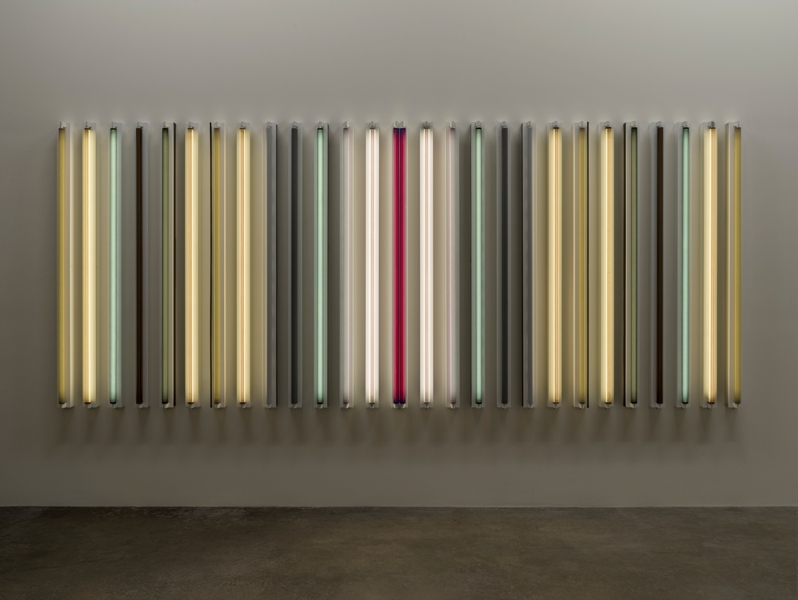
Robert Irwin, South South West (2014–2015).
Photo: Courtesy Pace Gallery
4. Robert Irwin at Pace, through May 9.
“Cacophonous” is a literally luminous exhibition of eight new compositions of wall-mounted, glowing florescent tubes by the San Diego-based pioneer of the California Light and Space movement, Robert Irwin. He has been producing similar works for years, but this is the strongest exhibition of them I have seen.
Using rows of abutting columnar fixtures of florescent lights coated with variously colored gels, Irwin employs what are basically industrial materials to bathe the room in an ethereal, celestial glow. Some tubes are unlit, simply reflecting the adjacent tubes and the extant light in the room. The works conjure specific times of day and seasonal light effects, plus specific places, as in Harlem Nocturne (2014-15). After spending some time with them, they can even hint at certain emotional states.
In contrast to Dan Flavin’s installations using similar materials, Irwin’s encompasses an exploration of the phenomenological effects of light, shadow, and reflection. Irwin’s works are panoramic, almost pictorial, and have a romantic feel. One outstanding example, South South West (2014-15), is a row of twenty-eight tubes, six feet high, and spanning some sixteen feet across. Delicately nuanced tones of green, gray, and gold from the sides lead to a central fixture comprised of two glowing deep red tubes, like the warm rays of a setting sun flickering over an arid landscape.

Installation view, Pieter Schoolwerth, Your Vacuum Blows, which Sucks (2015).
Photo: Courtesy Miguel Abreu Gallery.
5. Pieter Schoolwerth at Miguel Abreu, through May 3.
Best known for his quasi-surrealist figurative paintings, Pieter Schoolwerth shows off a broader range of interests in this zany two-part show, “Your Vacuum Blows, which Sucks,” held in both Miguel Abreu venues on the Lower East Side.
In the Orchard Street space, Schoolwerth presents Your Vacuum Sucks, a video he produced last year in collaboration with Alexandra Lerman. This wacky bohemian melodrama centers on the trials and tribulations of ordinary household appliances, particularly with the titular vacuum cleaner.
The quirkiness of the film, which shares some of the loony energy of Ryan Trecartin’s films, carries over to the installation filling the larger space at Eldridge Street, which is at once tacky and tremendous. Here, a new series of vibrant, large-scale paintings, made with photographic ink-jet images combined with painted elements, plus numerous collages, appear in disjointed makeshift rooms. Some of the plywood walls are painted on one side with garish colors. Mechanical household appliances, like electric fans, vacuum cleaners, and a sewing machine, are placed precariously within cut-outs in the walls, echoing the fragmented images of these same items that appear in the nearby paintings. A jarring labyrinth of color and movement, the show conveys with biting humor a feeling of consumerist unease and, perhaps, late-capitalist anxiety.
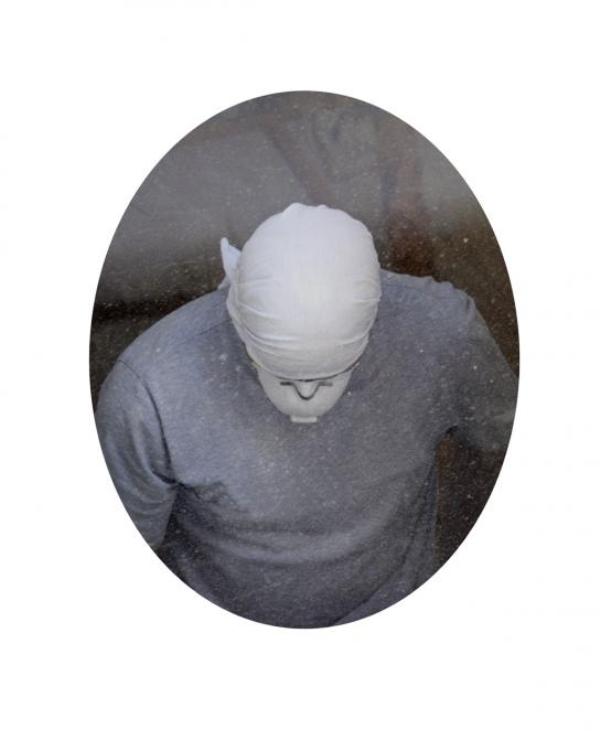
Arne Svenson, Workers #24 (2014).
Photo: Courtesy Julie Saul Gallery.
6. Arne Svenson at Julie Saul, through May 30.
Los Angeles-born, New York-based photo artist Arne Svenson maintains that you can only capture a truly naturalistic pose if the subject is unaware that he or she is being photographed. Following on the heels of Svenson’s controversial photo series, “The Neighbors,” which features furtive images of the artist’s neighbors shot with a telephoto lens from his apartment window (see Voyeuristic Photographer Arne Svenson Wins New York Appellate Court Case), the new series, “The Workers,” is similarly voyeuristic and remarkable. Using a comparable technique as in “The Neighbors,” and shooting his subjects from afar over the past two years, Svenson captures a sense of quiet repose in pictures of manual laborers at various work sites around town.
The grainy texture of the images in the series, which debuts in this show, often suggests a painted surface. Presented in an oval format, as a specific reference to Old Master portrait paintings, the photos have an iconic feel, and the laborers, a quiet dignity. Sometimes only a portion of an arm or leg is visible, but the picture may suggest an intensely lyrical, and sometimes vaguely erotic scene. The more portrait-like images can also imply a wide range of character types, although the subjects’ facial features are invariably obscured. This exhibition, incidentally, coincides with the release of Svenson’s book, The Neighbors, to which (full disclosure) I contributed an essay.
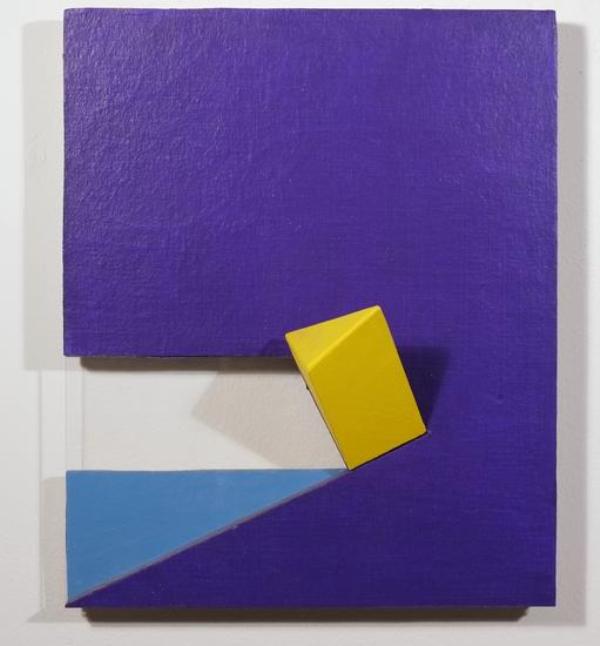
Charles Hinman, Wooster (2008).
Photo: Courtesy Washburn Gallery.
7. Charles Hinman at Washburn Gallery, through June 26.
Veteran painter Charles Hinman made a splash in the 1960s with his pioneering use of shaped canvases in abstract compositions that pushed the boundaries of what a painting could or couldn’t be. Subsequently, his experiments were appropriated by legions of painters, and, as is often the case in recent art history, his groundbreaking efforts fell into relative obscurity. Luckily, this exhibition, “Space Windows,” featuring a series of works executed in 2008, is a welcome reminder that Hinman has been producing excellent work all along, and ought to be better known today.
These meticulous constructions of geometric design are painted in buoyant hues, usually limited to three per work. Each composition, made of acrylic on non-woven acrylic fiber on wood, with Plexiglas panels, features a large wedge shape that protrudes from the canvas at nearly a right angle, and appears to slice through the surface. The spatial games Hinman thereby initiates in vibrant works such as Wooster and Prince, challenge the viewers’ depth perception. But Hinman is not merely after optical tricks. These distinctive objects, spare and emphatic as they may be, bear a monumental and timeless quality.
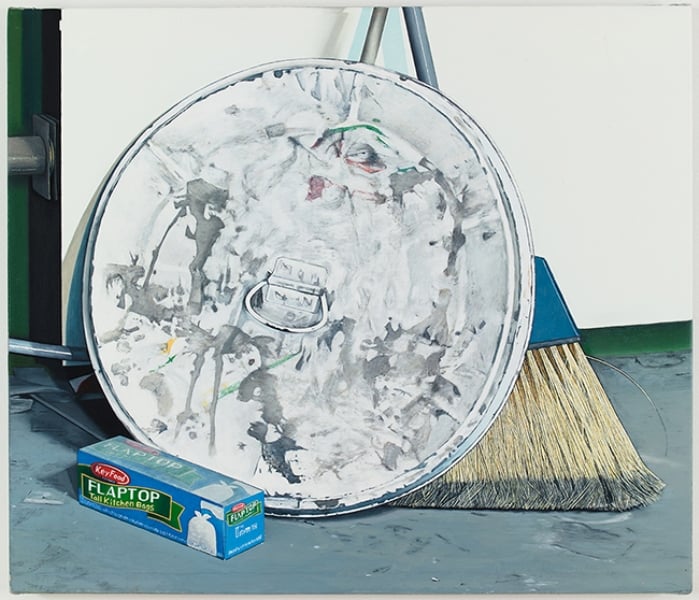
8. Caleb Considine at Bureau, through May 3.
Los Angeles-born New York painter Caleb Considine is only 33, but the works in this show exude a command of the medium and an ease with experimentation that one usually associates with a seasoned veteran. The range of his imagery and technique is impressive, from super-realist still-life painting to pure gestural abstraction. But the works are united by a palpable intensity and clarity of focus. There’s no fooling around here. Though the works are small in format, the ambitions are big.
Trash Theme (2015) is a low-lying close-up view—maybe the point of view of a cat or dog—showing a broom and trash can lid leaning against a wall, and a box of plastic kitchen bags lying on a concrete floor. The works’ crisp lines and the well-realized textures contribute to its veracity. One may be tempted to find an allegorical aim in the content but the image seems rather personal. Likewise, with Decade of Brutality. Here, the artist has covered parts of a pair of white sneakers with blue spray paint, and made the old footgear the unlikely subject of an exceptionally compelling painting.
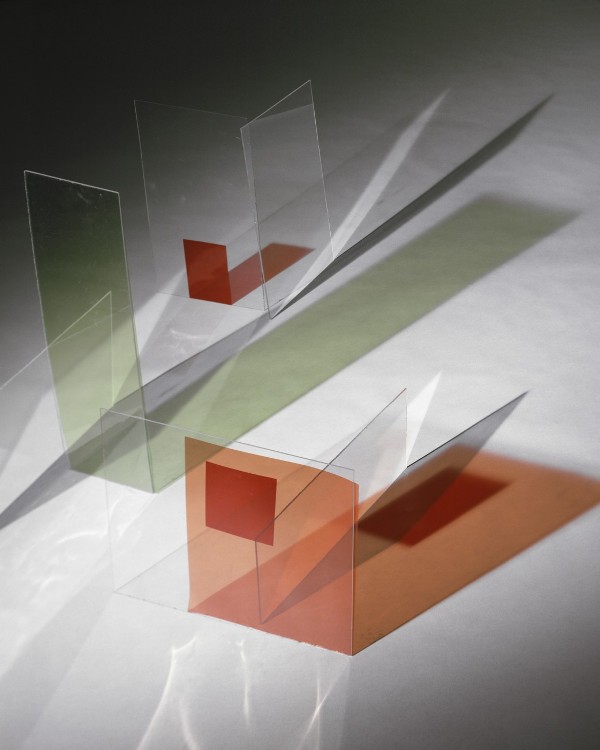
Barbara Kasten, Transposition 9 (2014).
Photo Courtesy Bortolami.
9. Barbara Kasten at Bortolami, through May 2.
Coinciding with Barbara Kasten’s career retrospective currently on view at the Institute of Contemporary Art in Philadelphia (see Christian Viveros-Fauné Selects 15 Artists to Watch in 2015), this exhibition, “Set Motion,” gives New York audiences a chance to explore Kasten’s experiments in melding photography with sculpture. The recent large-scale photos on view, part of a series called “Transpositions,” are the standouts here. For these works, she photographs geometric constructions she makes with clear and tinted Plexiglas geometric shapes. The resulting abstract photos feature complex networks of reflections and multiple perspectives that are impossible to unravel.
Also on view is a recent black-and-white video projection, Sideways, whose shifting abstract forms play against the architectural details of the gallery space. In a rear gallery, a series of abstract photos from the 1970s, titled “Amalgams,” sometimes embellished with paint and crayon, feature dark squares and rectangles, plus intricate configurations of fragmented geometric shapes. They closely correspond to the more recent works, and seem equally fresh and of-the-moment.
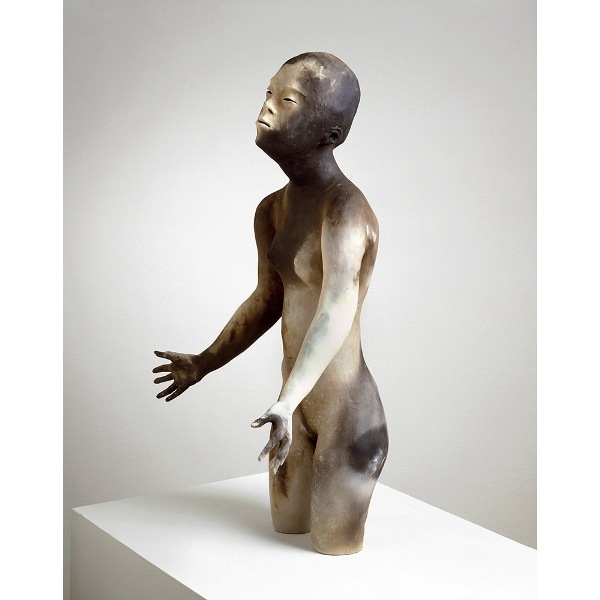
Daisy Youngblood, Budhi (2006).
Photo: Courtesy McKee Gallery.
10. Daisy Youngblood at McKee Gallery, through May 30.
Daisy Youngblood produces only a few sculptures each year, so this exhibition of 14 key works, “Daisy Youngblood: Ten Years 2006-2015,” represents a significant portion of her output over the past decade. The show is not to be missed. The North Carolina-born artist, who now lives and works in Costa Rica, has a specific, and eccentric, approach to rendering mostly small- and medium-size figures and animals, and her use of materials is consistently unconventional and surprising.
In a number of works, including the most recent piece on view here, Chandrika (2014), Youngblood incorporates driftwood, stone, and low-fire clay. This extremely distorted yet convincing figure, suggests a sleeping woman with a rather abject and mournful comportment, as one who has suffered a great deal. The elegance of the shapes and the ultra-sensitive manipulation of the materials, however, ultimately lend the figure a dignified grace. Some of the sculptures have a genuinely emotional pull, such as Budhi (2006), a small, low-fire clay sculpture depicting the artist’s daughter, who has Down’s syndrome. This striking work, with delicately lithesome limbs and torso, recalls an especially refined work of Maya art, or a masterpiece from some other long lost civilization.
David Ebony is contributing editor of Art in America and a longtime contributor to artnet.